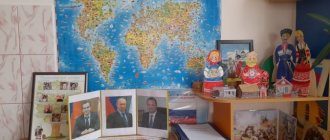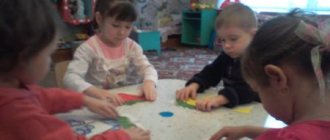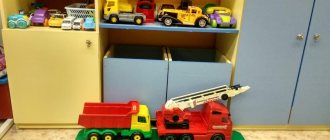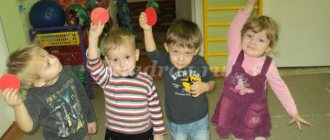Photo report “Subject developmental environment in the first junior group”
Olga Zhigalova
Photo report “Subject developmental environment in the first junior group”
Educator: Zhigalova O. Yu.
One of the important conditions for educational work in a preschool institution is the correct organization of the subject-development environment .
When creating a developmental space in a group room, it is necessary to take into account the leading role of play activity in development, this in turn will ensure the emotional well-being of each child, the development of his positive sense of self, competence in the field of relationships with the world, with people, with himself, inclusion in various forms of cooperation, which are the main goals of preschool education and upbringing.
When creating a developmental environment for children of primary preschool age, first of all, we paid attention to creating conditions that ensure the safety and psychological comfort of each child in the group . We strived to ensure that the atmosphere in the group was close to homely and cozy.
Functions of a subject-related environment in the junior group :
Cognitive – satisfies the child’s need to master the world around him, stimulates cognitive activity;
Communicative – stimulates speech development, allows the child to learn the basics of communication and interaction;
Wellness – stimulates motor activity, enriches motor experience, introduces to the culture of health;
Creative – introduces children to creative activities, promotes self-development and self-realization.
In our group, the subject-development environment is divided into corner-centers for children’s independent activities:
Fine Arts Center:
Objectives: To develop interest, attention, curiosity, and emotional response of children to individual aesthetic properties and qualities of objects in the surrounding reality.
Center for Psychological Relief
Objective: reducing the child’s anxiety level, performs a calming and relaxing function.
Music and theater center:
Objectives: Development of auditory perception and attention; formation of performing skills; development of children's creativity based on literary works.
Nature Center:
Objectives: Environmental education and education of children. Foster love and respect for nature.
Center for role-playing games.
Objectives: to promote the emergence of the game; develop the ability to choose a role and perform several interrelated actions in the game; formation of communication skills in the game; development of imitation and creative abilities.
Physical Culture Center:
Objectives: Create conditions for physical exercise in a group , stimulate children’s desire to engage in physical activity.
Sensory center.
An important condition promoting sensory development is a specially organized developmental environment , which includes: a teaching table, pyramids, different colors, different shapes and textures, lacing, a variety of inserts, educational games, large mosaics, volumetric inserts of 5-10 elements, prefabricated toys, a set of geometric figures, objects of various geometric shapes, insert boards, insert frames.
Book Center:
Objectives: Formation of listening skills, ability to handle a book.
My kids love it when we read books with them and look at pictures, so here we have a lot of bright, colorful and interesting literature on the program.
Our favorite center in our group is the construction center. After all, it contains construction sets of various shapes and sizes, from different materials, as well as characters and cars for playing out buildings. The main tasks of this center are to develop the desire to build buildings according to one’s own design, to develop fine motor skills of fingers and hands, and to acquire the ability to build furniture, slides, and houses.
LOCKER ROOM AND BOOTH MATERIAL IN LOCKER ROOM
in the group is accessible to every child, is age appropriate and takes into account their individual characteristics and developmental capabilities.
Card index of games for young children
Card index of games
for
young children
№.1.
D/I “LONG - SHORT”
GOAL: To continue to develop the sensory abilities of children, to be able to distinguish objects by length, to use “long - short”, “longer - shorter” in speech, to develop imagination and thinking. GUIDE: The game is played with 2-3 people. First, we consider the ribbons by length, then the children are offered cards and flat sticks of different lengths and colors. By unfolding, the child determines where the long and short sticks are.
№2.
D/I "INSERTS"
GOAL: To be able to perform actions with geometric shapes (circle, square, triangle), insert shapes, develop memory, thinking and attention. GUIDELINES: The game is played with a subgroup of children of 4-5 people. The teacher first shows geometric shapes, names them and shows the children how to insert them into stencils. During the game, constantly fix the names of the figures - circle, square, triangle.
№3.
D/I “FIND THE SAME FLOWER”
GOAL: Continue to develop children’s sensory abilities, consolidate 4 primary colors, and the ability to name flowers by demonstration. GUIDELINES: The game is played with 4-5 people. First, the teacher shows the children large illustrations of flowers of different colors. Children tell what color these flowers are. Then the teacher gives the children 4 small cards, having examined them, he offers to show the same flower as the teacher shows.
№4.
D/I “CIRCLE AND SHAD”
GOAL: To develop and consolidate children’s sensory abilities, the ability to shade a circle, square, triangle using a stencil on a white sheet, and to consolidate primary colors. INSTRUCTIONS: First, the teacher shows the children (2-3 people) stencils of geometric shapes. The children look at what color it is, then the teacher shows how he shades on a white sheet of paper with the same pencil as the stencil. The teacher distributes paper, stencils, pencils, and he himself makes sure that the children correctly select the color of the pencil to the stencil.
№5.
D/I “ONE IS MANY”
GOAL: To develop first mathematical abilities, develop attention, thinking, and the ability to distinguish the color of objects. GUIDELINES: Games are played with 2-3 children. The teacher shows pictures of toys on a magnetic board - one, many, and fixes the color. Then he invites the children to find and attach the same pictures as shown.
№6.
D/I “MULTI-COLORED BALLS AND CLOSES PEGS”
GOAL: Continue to develop fine muscles of the hand, consolidate knowledge of color, develop attention and imagination. GUIDELINES: The game is played with 2-3 people. “Granny” comes and complains that the kittens have unwound all the balls, invites the kids to wind up a ball for each, and then hang the clothespins on the handle of the basket. Constantly involve children in productive activities.
№7.
D/I “BIG, SMALL, SMALL”
GOAL: Continue to develop the ability to distinguish geometric shapes by size, develop conversational speech, thinking, memory, and the ability to distinguish primary colors. GUIDE: The game is played with 2 children. The teacher shows a set of geometric shapes (circle, square, triangle) of different colors, and suggests showing first a large figure, a smaller one, then a small one. You can complicate the game by asking: “Show me a small red triangle”; "Large circle of yellow color"; “A smaller yellow square,” etc. at the discretion of the teacher's imagination.
№8.
D/I “MULTI-COLORED DROPS”
GOAL: Continue to strengthen children’s sensory abilities, the ability to pipet as directed and drop into cells by color, develop memory and thinking. GUIDE: The game is played with 2 children. The teacher shows jars with multi-colored gouache. At first 2 colors, by the end of the year 4 main colors. Gives everyone a drawing and a palette with cells by color. Shows actions. Then he invites the children, following a verbal guide, to type in a jar and drop into the cells without mixing the colors. Each action is discussed with each child.
№9.
D/I “SHOW THE SAME”
GOAL: Continue to strengthen the ability to find the desired geometric figure (circle, square, triangle), develop thinking, conversational ability to name the color of the figure. GUIDELINES: The game is played with 2-3 people, as it is necessary to focus the attention of the children. Bunny comes to visit and brings a box with geometric shapes and asks to tell the children what it is. First, the teacher shows the figure and its color separately. Then he distributes sets of figures to the children and, according to his demonstration, asks to show the child, constantly involving him in speech activity.
№10.
D/I "RED, YELLOW, BLUE, GREEN"
GOAL: To develop the ability to distinguish, name and show pictures by the color of objects, to develop children’s sensory abilities. GUIDELINES: The lesson is conducted with 5-6 people. Each child has a picture of objects on the table (toys, flowers, clothes of different colors). The teacher shows either a picture of a certain color or an object of the same color. The child must show his own picture with the same image and color.
№11.
D/I “FIND A BUCKET FOR MATRYOSHKA”
GOAL: continue to consolidate and name the 4 primary colors, develop thinking, memory, and speaking. GUIDE: The game is played with 2 children. A set of matryoshka dolls of red, green, blue colors and buckets of the same color are separated. First, the teacher shows which bucket each nesting doll needs. Then he invites the children to find a bucket for the nesting doll, fix the name of the color of the matryoshka dress and the bucket, and involve the children in speech activity with various questions.
№12.
D/I “INSERT BUSHING”
GOAL: Continue to develop hand motor skills, attention, and thinking. GUIDELINES: The game is played with 4-5 children. The teacher shows the planes, along the edges of which there are holes for bushings. He shows and discusses his actions, then invites the children to repeat what they saw.
№13
D/I "BUSINKS"
GOAL: To develop motor skills of the hands, the ability to take beads with tweezers and arrange them into cups according to external features, to develop thinking and memory. GUIDELINES: The game is played with 2 children because it requires a lot of attention. First, the teacher shows actions with tweezers and beads, and then invites the children to sort the beads into cups.
№14
D/I “LACE YOUR BOOT”
GOAL: To develop the ability to perform actions with screwing, to develop small muscles of the hands, and to develop thinking. GUIDELINES: The game is played with a subgroup of 4-5 children. A child from another group comes and asks to help him lace his shoes. The teacher performs the action. And then he hands out “boots” and laces to the children and offers to lace the doll’s boot.
№15
D/I "COLOR DOMINO"
GOAL: Continue to develop children's sensory abilities by finding an object of a given color, fixing the 4 primary colors. GUIDELINES: The game is played with 4-5 children. 2-3 colored dominoes are distributed to everyone. Children are invited to lay out a path, looking for dominoes of the same color as the color of the domino the previous child placed.
№16.
D/I “LAYING OUT HOMOGENEOUS OBJECTS OF DIFFERENT SIZES”
GOAL: To learn to find the same geometric shapes (circle, triangle, square), but of different sizes. GUIDELINES: The game is played with 4-5 children, each with plane images of a circle, triangle, square of different sizes and can be of different colors. The teacher suggests choosing your own geometric shapes based on the demonstration.







